Rack Linear Synthesizer

The rack version of the D-50. Here’s an audio contribution from a reader – a demo of several of its presets:
Roland D-550 audio demo
Roland D-550 manual
Roland D-550 links
Rack Linear Synthesizer

The rack version of the D-50. Here’s an audio contribution from a reader – a demo of several of its presets:
Roland D-550 audio demo
Roland D-550 manual
Roland D-550 links
analog monosynth
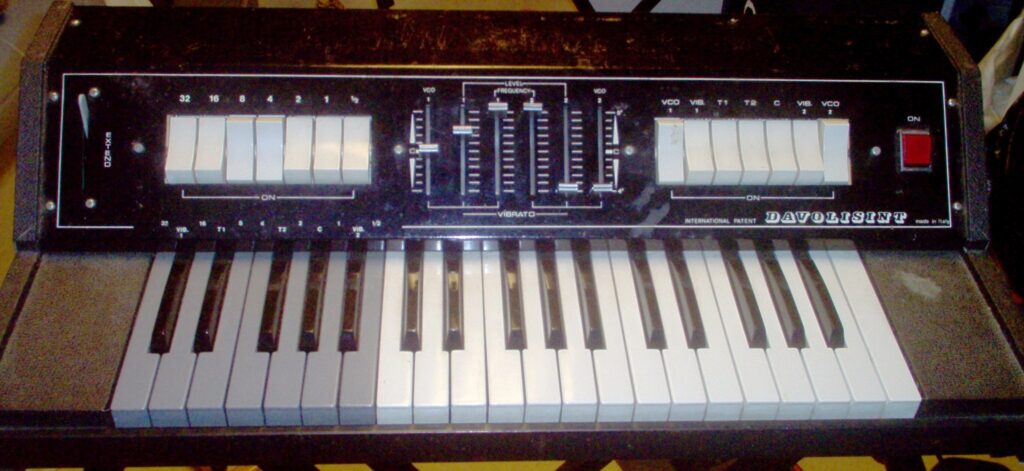
Here we have a very cool monosynth from the early ’70s, the Davolisint!!!
It is a very compact and relatively light synthesizer, well built to last. It has an unusual design (perhaps the reason for this was to keep cost down), seen that while it has two VCOs (YES!), there are sadly no filters or envelopes.
Let’s do a rundown of the main panel:
From the left, there’s a funky looking lever labeled “EXTEND”. This is a pitch-bend lever, that bends the sound up to one full octave (you pull the lever down and the pitch goes up, go figure) It is a very useful features and allows the typical 1970s synthesizer expression. It is spring loaded and it returns to its original state, somewhat more slowly than we are used to have pitch benders return, these days.
Then there’s a set of seven white rocker switches labeled 32 to 1/2. These are simply the footage switches for the basic waveforms (similar to an electronic organ). You can have them all on at the same time, or mix and match as you please.
In the middle of the panel there are six sliders: the first controls the VCO 1’s pitch (fine tune, up 1 tone, down 1/2 tone); the next four control the vibrato frequency and intensity, independently for both oscillators. Then there’s VCO 2’s pitch slider: this offers a larger pitch excursion than OSC 1, going up one full octave, and down almost one octave (great for those detuned Moog-like synth lines).
To the right of the panel there are seven more white rocker switches: the first one turns on VCO 1, the second and third switch on vibrato and portamento, respectively, for VCO 1 (portamento is indicated with “T”). The fourth is the portamento switch for VCO 2. Then there’s a switch called simply “C”: what it does, it simply turns on the lowest C on the keyboard (on the white keys), to obtain a drone. Why this is, I have no idea. Maybe to tune the other instruments of the band? After the “C” key, there’s a rocker switch to turn on vibrato on VCO 2, and finally a last rocker switch to turn on VCO 2 itself.
A big red switch concludes the front panel. All the switches and sliders are clearly labeled with their functions.
NOTE: The keyboard only offers two octaves (the white keys). The grey set of keys (one octave) to the extreme left is simply a set of keys that act as momentary switches for the same controls that are being offered via the rocker switches. This is probably to offer the performer a more ample range of expression – i.e., it’s easier to engage the portamento momentarily, using the grey keys, and more expressive than just turning the rocker on the whole time. Well, this is also debatable.. I would probably have preferred another octave to play, rather than having this basically – repeated – set of controls.
Yes, but how does it SOUND??? Well, scroll down to hear examples from this Italian beauty; it actually sounds pretty good! While the main character is simple, the tones achievable and certainly fat, very expressive, and quintessentially ANALOG. In certain settings, and with the right technique, you can even achieve a Minimoog-type sound, and that’s a BIG compliment!!! Of course, this is a lot simpler than a Mini, but if you can’t afford the old faithful, this is a fun alternative!
Davoli Davolisint audio demos
(I ran the synth through a Lexicon MPX-1 multieffect)
Davoli Davolisint photos
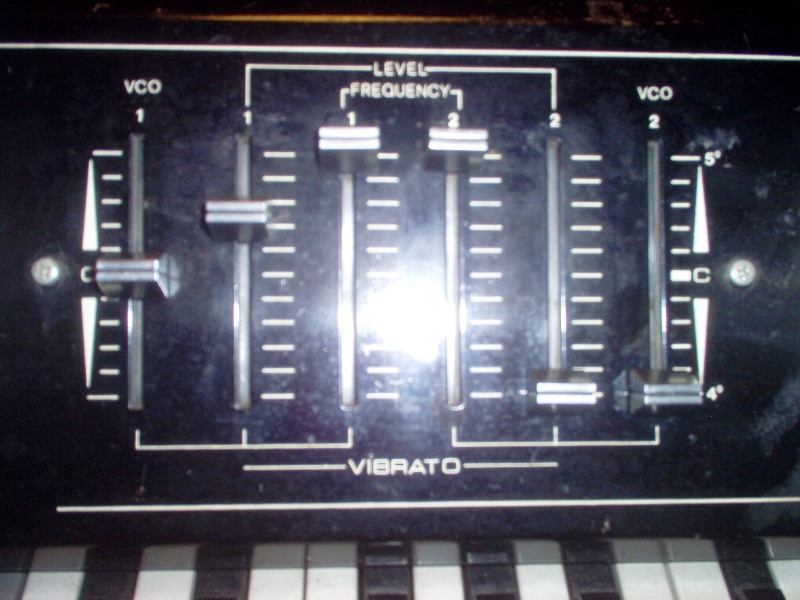
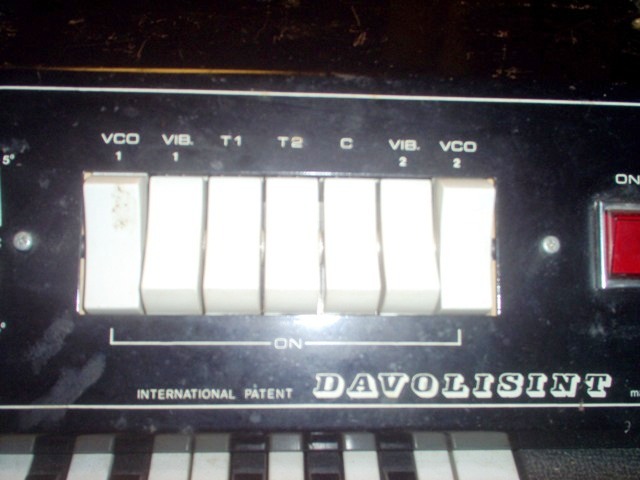
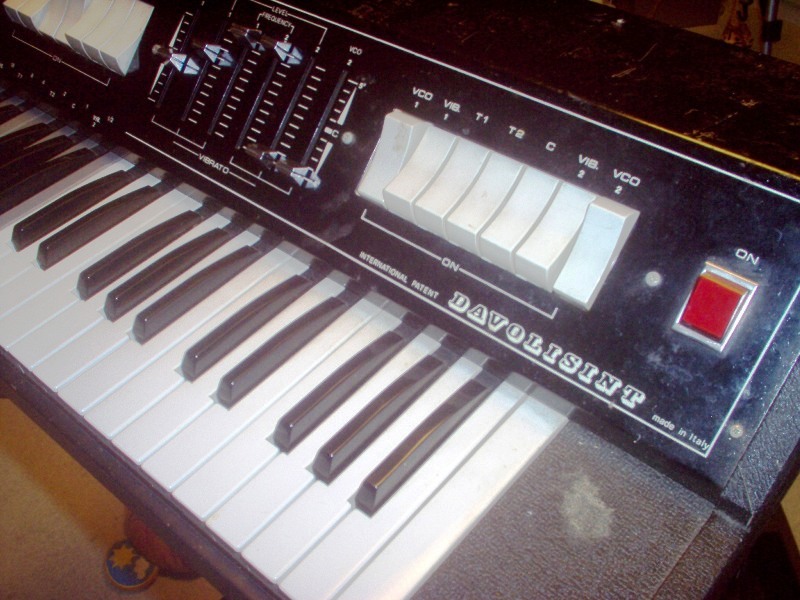

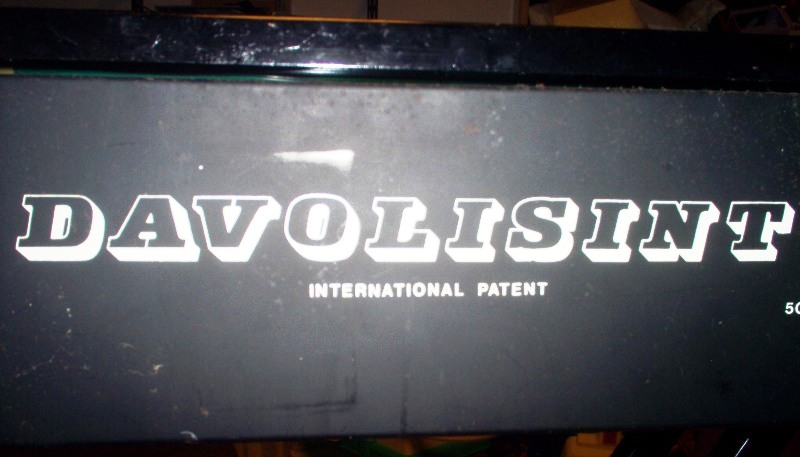

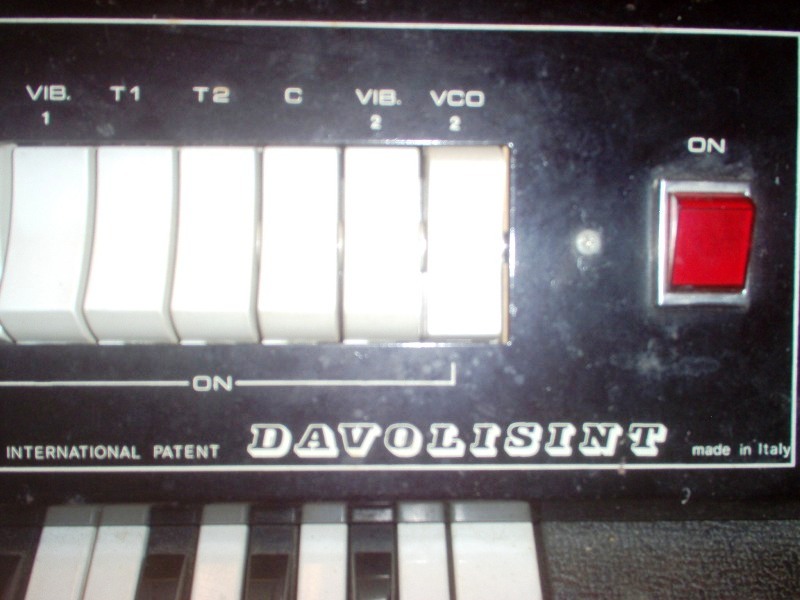
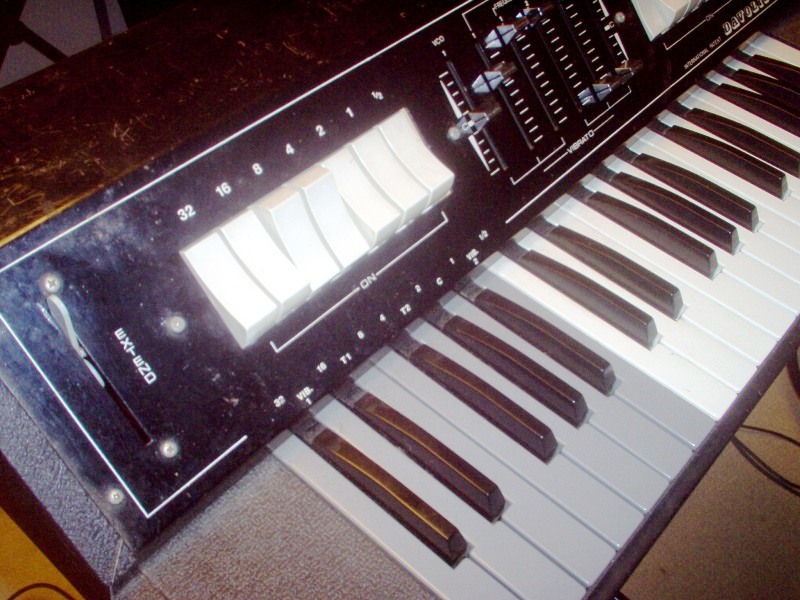
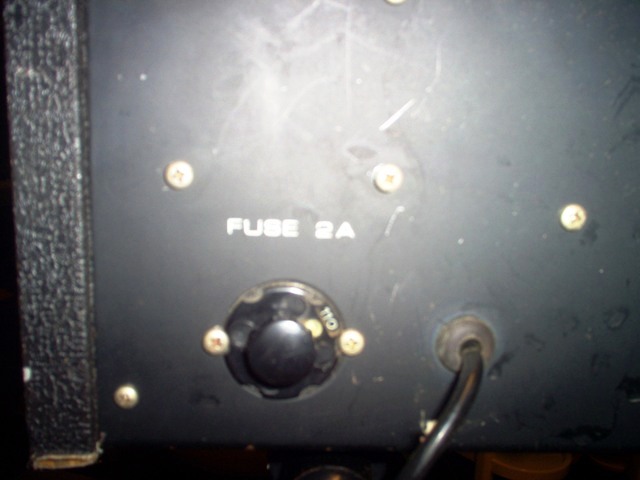

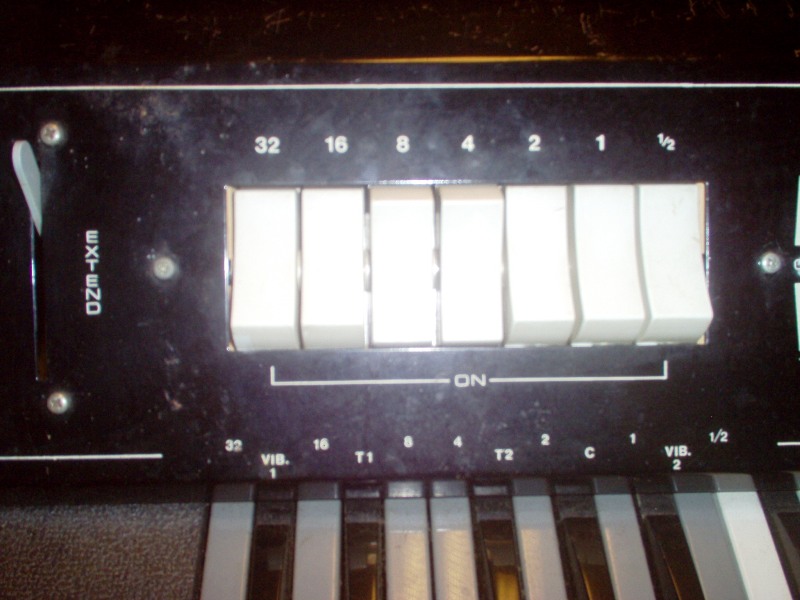
Davoli Davolisint manual
Not found yet
Davoli Davolisint specs
| Year of release | 1972 |
| Polyphony | monophonic |
| Sound generation method | 2-VCO |
| Preset memories | no |
| MIDI | no |
| Sound expansion capabilities | no |
| Sequencer | no |
| Arpeggiator | no |
| Effects | portamento |
| Touch sensitivity | no |
| Aftertouch | no |
Davoli Davolisint links
Digital programmable algorithm synthesizer

The most famous synthesizer of the 1980s.
Its electric piano became a standard sound in ballads and “smooth jazz” genres. Its bass was the standard bass sound, typically played in bouncy octaves. Its crystalline timbres were such a departure from the world of analog, that this synth was a super-hit for Yamaha in 1983, and spanned a long family of FM-based products.
The DX7 came out in 1983, sporting the new MIDI interface. The high quality of its digital sounds, velocity + aftertouch, the expandability, the thoroughly professional look, and the complicated programming interface, made the DX7 and FM synthesis take off in a way the was unknown before for synthesizers. Thousands of units were sold, and thousands of records have that distinct DX7 sound (especially for the electric piano, the bass, marimba and glassy, crystal-type sounds).
The DX7 was also the first synth that originated a huge “patch creation” business. Since it was cumbersome to edit, many programming houses were established, ready to feed the hunger for new sounds that players all over the world craved. Today, there are literally thousands of sounds available for the DX7.
Bottom line: together with D-50 and M1, the synthesizer of the ’80s
Yamaha DX7 audio demos
Factory internal presets (ROM-1 A MASTER GROUP)
ROM 1-B KEYBOARD AND PLUCKED SOUNDS GROUP
ROM 2-A ORCHESTRAL & PERCUSSIVE SOUNDS GROUP
ROM 2-B SYNTH, COMPLEX & EFFECTS SOUNDS GROUP
ROM 3-A MASTER GROUP
ROM 3-B KEYBOARD & PLUCKED SOUNDS GROUP
ROM 4-A ORCHESTRAL & PERCUSSIVE SOUNDS GROUP
ROM 4-B COMPLEX SOUND & EFFECTS GROUP
Yamaha DX7 photos

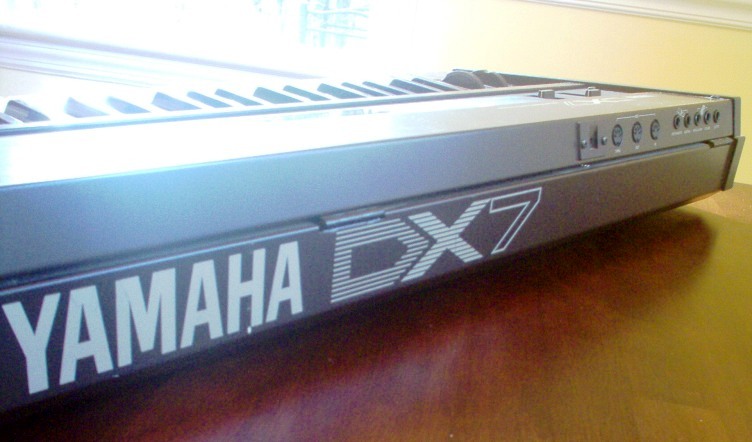

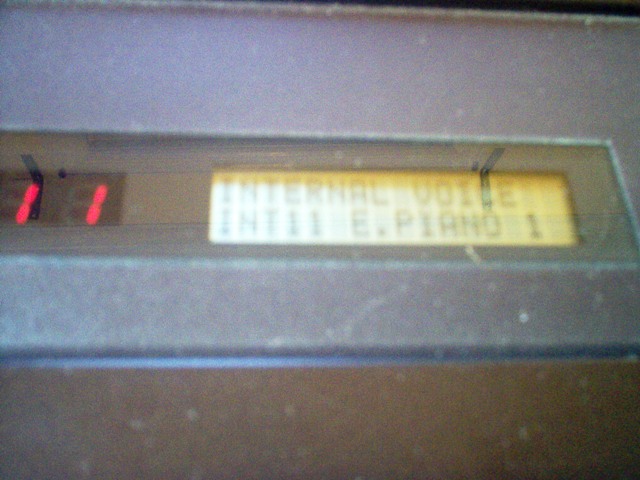
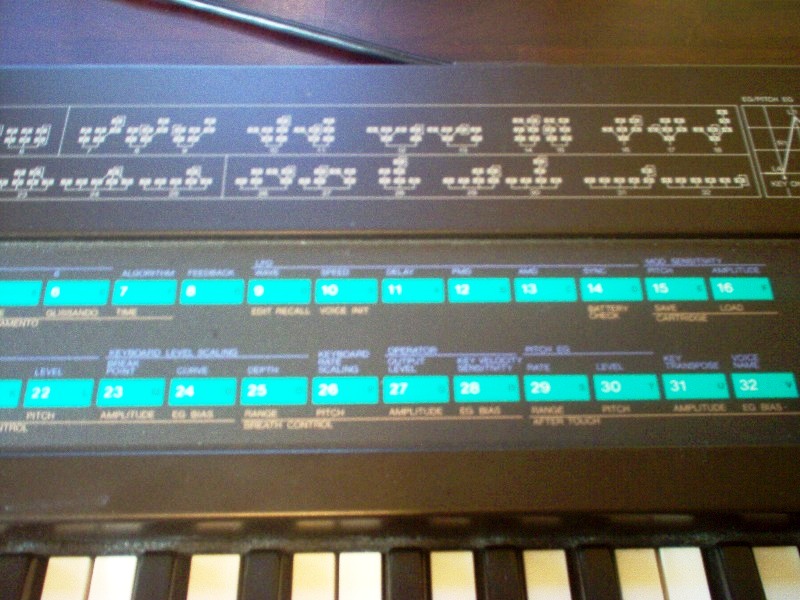
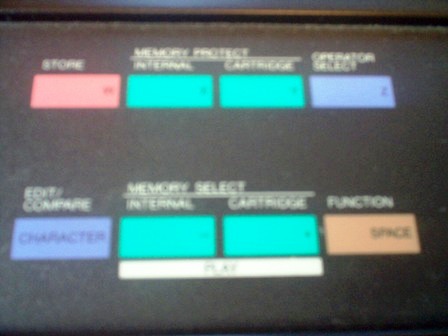
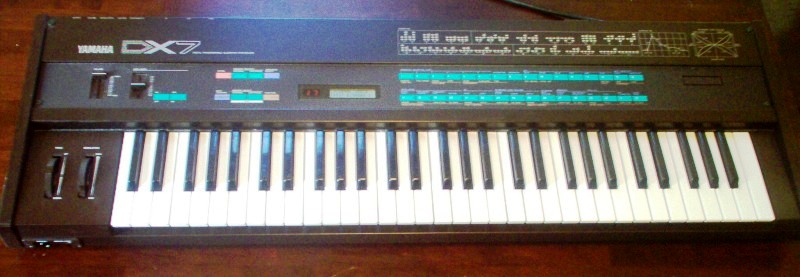
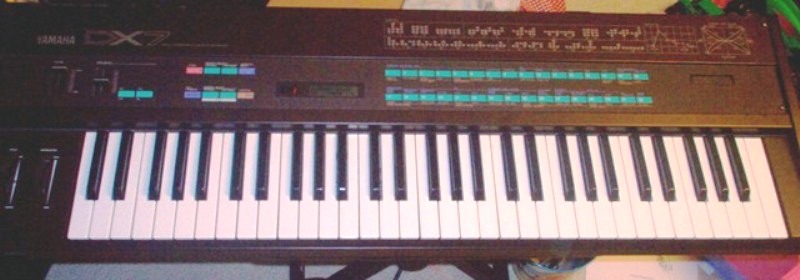
Yamaha DX7 patches
Don’t forget to press FUNCTION (SPACE) and then Nr. 8 to switch from UNAVAIL to AVAIL when loading patches from your sequencer, or the DX7 won’t receive the MIDI sysex.
Yamaha DX7 manuals
Yamaha DX7 specs
| Year of release | 1983 |
| Polyphony | 16 |
| Sound generation method | FM |
| Preset memories | 32 + expandable via cartridges |
| MIDI | in, out, thru |
| Sound expansion capabilities | cartridges |
| Sequencer | no |
| Arpeggiator | no |
| Effects | no |
| Velocity | yes |
| Aftertouch | yes |
| Accessories | ROM cartridge x 2 (64 voices x 2); music stand |
| Dimensions | 101.8cm (W) x 10.2cm (H) x 32.9cm (D) (40″ x 4″ x 13″) |
| Weight | 14.2 kg (31.2 lbs) |
Yamaha DX7 links
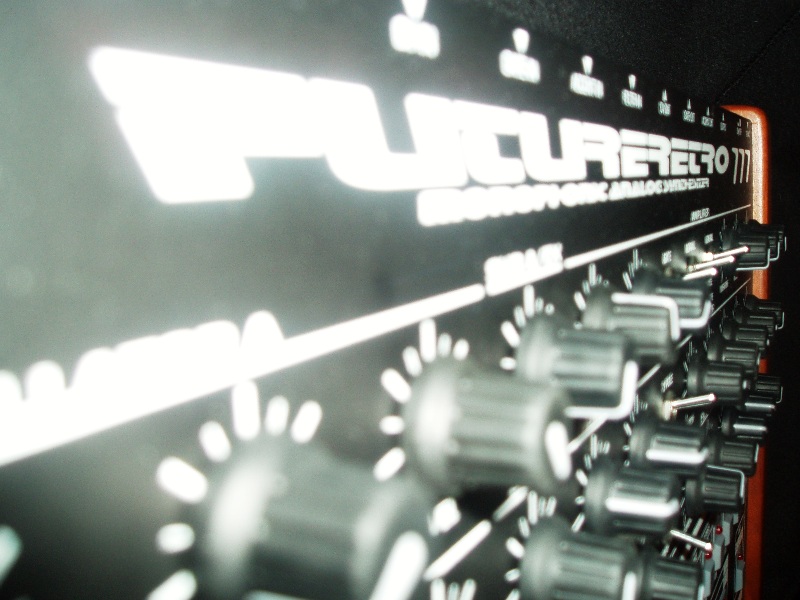
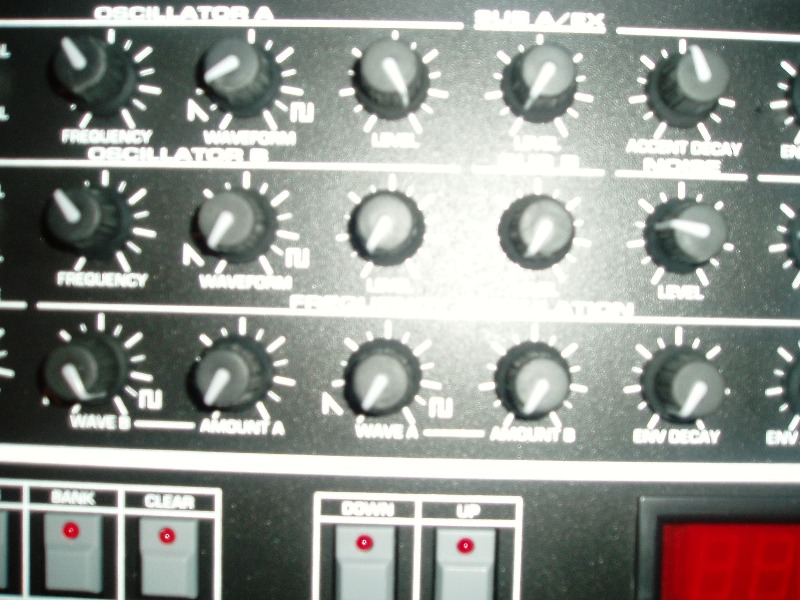
Desktop analog monophonic synthesizer inspired by the TB-303, with added functions and capabilities.
Two pictures and one audio demo submitted by a reader:
Manual and documents from the company website:
Factory sysex files from the company website:
Specs:
| Year of release | 1998 |
| Oscillators | Two, analog |
| Polyphony | Monophonic |
| Effects | n/a |
| Sequencer | Yes, pattern |
| MIDI | In, Out |
| Dimensions | 18″ width, 9″ depth, 3″ height |
| Weight | 5 lbs. |
| Power | 12 volt AC input, 1 amp or 1000 mA |
| OS | V3.10 is the latest OS for the 777 |
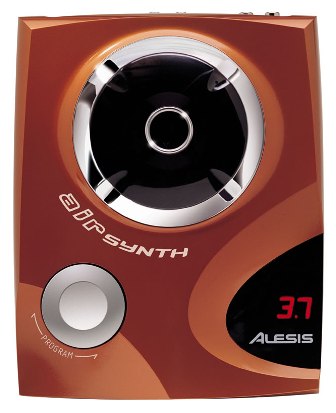
synth/theremin/sound effect generator
Alesis airSynth audio demos
Alesis airSynth photos
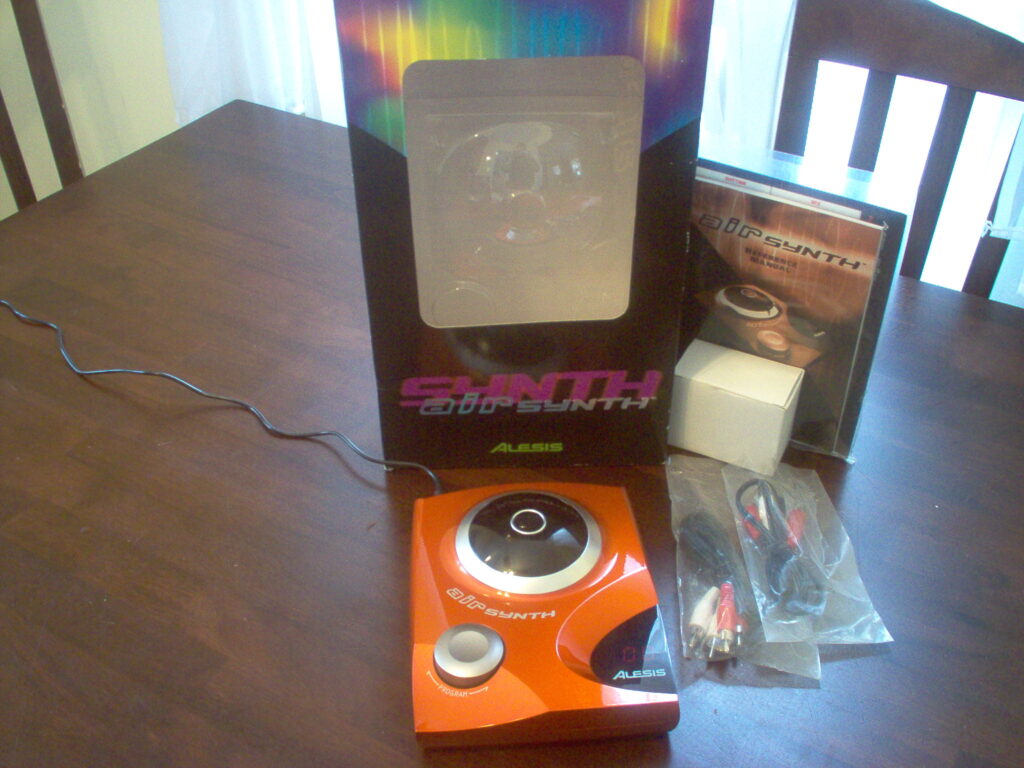
Alesis airSynth manual
Alesis airSynth specs
| Year of release: | 2001 |
| Polyphony: | monophonic |
| Sound generation method: | |
| Preset memories | 50 |
| MIDI: | no |
| Sound expansion capabilities: | no |
| Sequencer | sort of |
| Arpeggiator | sort of |
| Effects | no |
| I/O | Stereo RCA in and out |
| Resolution | Converter: 24bit; Processor: 28bit |
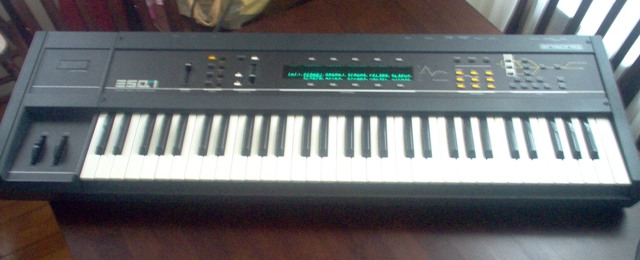
Digital Wave Synthesizer
Ensoniq ESQ-1 audio demos
(FACTORY PRESETS ver. 3.50 – latest version)
INT1
INT2
INT3
INT4
Ensoniq ESQ-1 photos

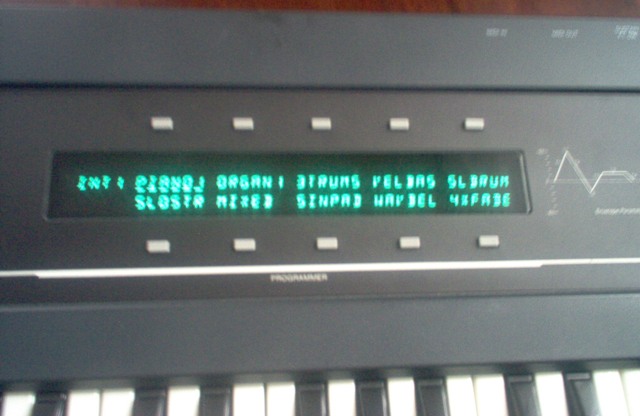
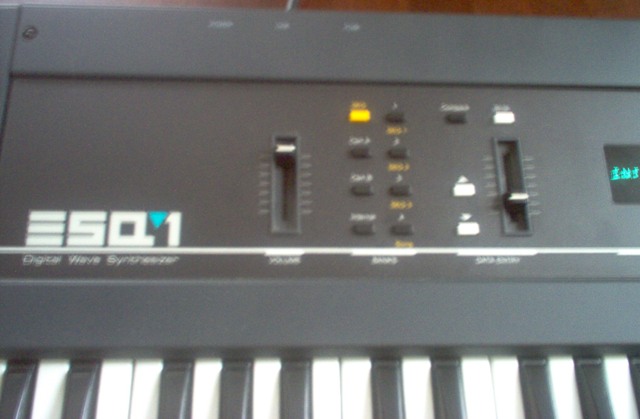
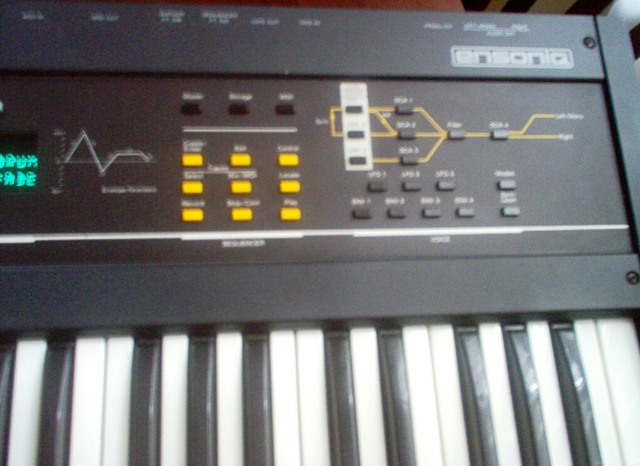
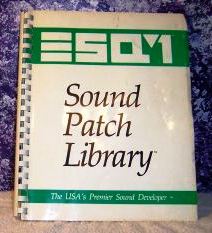
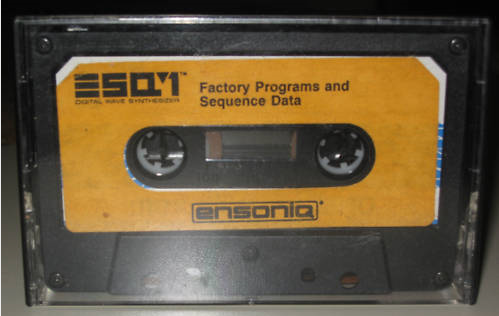
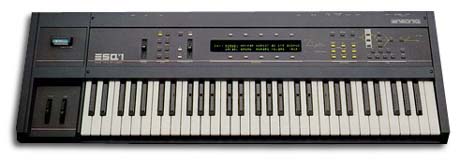
Ensoniq ESQ-1 manual
Ensoniq ESQ-1 specs
| Year of release | 1986 |
| Polyphony | 8-voice |
| Sound generation method | analog, 3 DCOs |
| Preset memories | 40 + 80 on cartridge |
| MIDI | in, out |
| Sound expansion capabilities | cartridge |
| Sequencer | yes |
| Arpeggiator | no |
| Effects | no |
| Touch sensitivity | yes |
| Aftertouch | no |
Ensoniq ESQ-1 links
Digital/Analog synthesizer
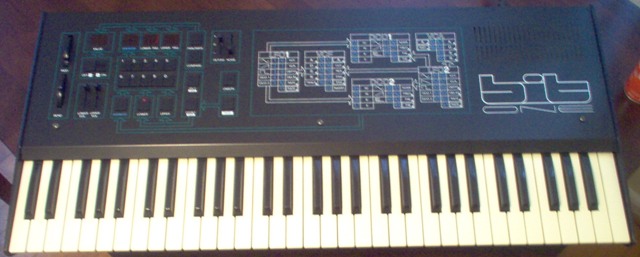
This black beauty is one of the many semi-unknown Italian synthesizers of the ’80s. It is a typical digital/analog hybrid, sporting two DCOs, VCF, VCA, and two LFOs. The programming on this synth can be a little cumbersome – it was the era of knob-gone digital after all… so programming is similar to other synths of the time: a keypad to change the parameter, and two up-down buttons to alter the value of the parameter dialed. The parameter list and flow diagram are stenciled on a large graphic in the middle of the front panel.
Several keyboard modes are provided; you can split the keyboard, or layer two sounds (double). There’s even a very cool Unison button that makes for some excellent, fat sounds. The pitch and mod wheels are above the keyboard, and on top of each other, as opposed to a more traditional side-by-side – for this reason, the Bit One is a nice, compact five-octave synthesizer.
The Bit One is a “stereo” synth, providing Upper (left) and Lower (right) separate outputs. The notes will come out of each channel at random. I’m not sure if it is a problem with my machine in particular or if all Bit Ones are like this. Best to stay in mono (Upper) if you don’t like the resulting effect.
There are four two-character displays: (parameter) value, address (the parameter selected), Lower Prg and Upper Prg. A compare button is also provided.
Crumar Bit One audio demos
Crumar Bit One photos

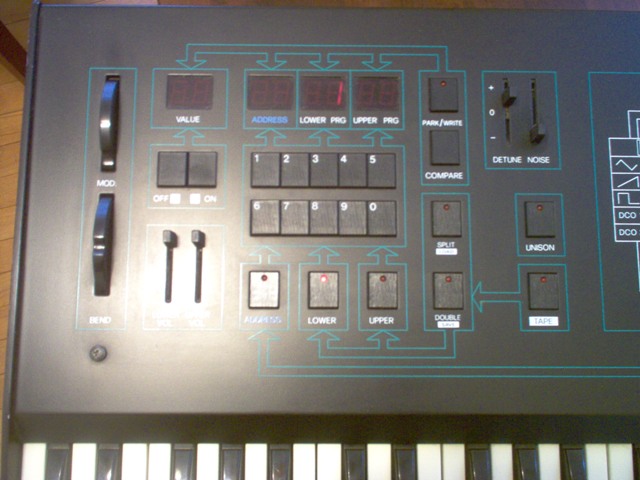

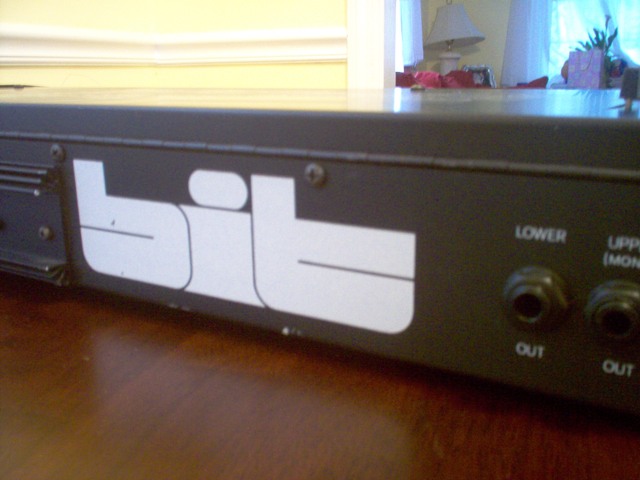
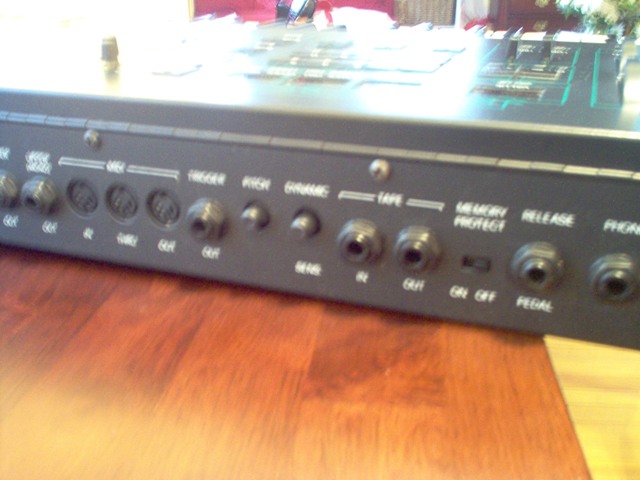
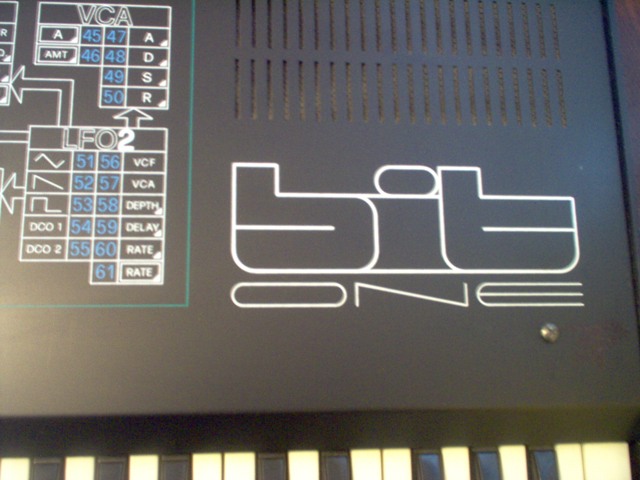
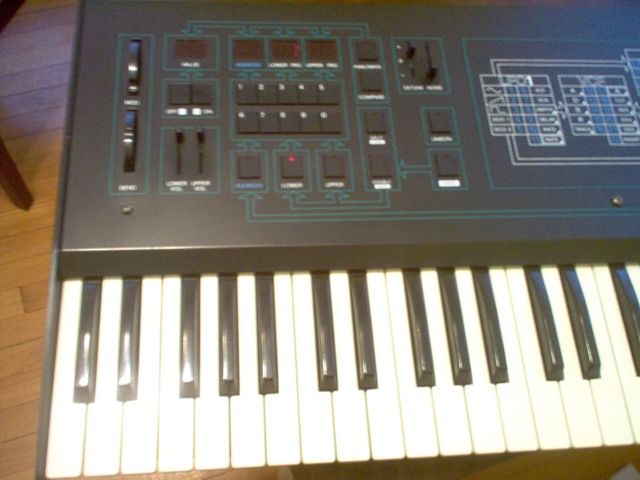
Crumar Bit One specs
Bottom line: If you want the “Sound of the ’80s”, this is a good choice.
| Year of release: | 1984 |
| Polyphony: | 6-voice |
| Sound generation method: | analog, 2 DCOs |
| Preset memories | 62 |
| MIDI: | in, out, thru |
| Keyboard modes: | Lower, Upper, Split, Double, Unison |
| Sound expansion capabilities: | No. Presets can be loaded/saved from/to tape. |
| Sequencer | no |
| Arpeggiator | no |
| Effects | no |
| Touch sensitivity | yes |
| Aftertouch | no |
| Other features: | Detune, Noise |
Crumar Bit One manuals and documentation
Here’s a .pdf of the original Factory Preset Name List, kindly provided by Don Turnock – who used to sell Crumar synths in the ’80s- thank you very much, Don, for providing all of us with precious, rare information on this synth!
And here’s a .pdf of the original Factory Preset Name List of Version II and III of the Bit One, plus MIDI information on the Bit 01, also provided by Don Turnock – thank you, Don!
Crumar Bit One factory patches in .wav
Crumar Bit One links
The Cruise is what was once referred to a “multi-instrument” keyboard, that is a synth having two or more sections designed to emulate a particular instrument, i.e., brass, strings, bass, organ, piano and so on.
They were popular in the early 80s, and other examples of this breed are the Crumar Orchestrator, the ARP Quadra, and the Korg Trident.
SIEL Cruise manual
SIEL Cruise specs
| Year of release | 1981 |
| Polyphony | Mono, Poly |
| Sound generation method | analog |
| Keyboard | 49-key |
Digital Sound Module

Casio CSM-1 audio demos
Let’s listen to the well-programmed DEMO SONG – “Night Birds”, by the British group Shakatak (thank you Vincent de Mulder for the tip 😉 ) – showcasing the best sounds of this module. Melodically, I really like this song, especially from 1:06 to 1:20 and similar, where the classic “Autumn Leaves” harmonic progression is employed to great effect. The piano is realistic enough – for a module of this era. And the crowd really liked the performers! 🙂
The sounds
The drum machine
Casio CSM-1 Tone List
| TONE NAME | TONE NAME | TONE NAME | TONE NAME |
| PIANO | CRASH CYMBAL 2 | COMPUTER GAME SOUND2 | ROBOT VOICES B |
| HARPSICHORD | SYNTH-CYMBAL 2 | TIMBALE (MIX) | ROBOT VOICES (MIX) |
| VIB | CRASH CYMBAL 3 | COMPUTER GAME SOUND3 | HONKY-TONK PIANO |
| ORGAN 1 | SYNTH-CYMBAL 3 | HI AGOGO | E PIANO |
| ORGAN 2 | CRASH CYMBAL(MIX) | LOW AGOGO | MARIMBA |
| BRASS ENS | RIDE CYMBAL 1 | HI CONGA (MUTE) | ORGAN 3 |
| FLUTE | GONG 1 | HI CONGA | ACCORDION |
| CHORUS | RIDE CYMBAL 2 | MID CONGA | STRINGS |
| JAZZ GUITAR | GONG 2 | LOW CONGA | OBOE |
| BELLS | TOM 1 | CONGA (MIX) | SYNTH 1 |
| CLAVI 1 | TOM 2 | HI CLAVE | HARP |
| METALLIC SOUND | SYNTH-TOM 1 | LOW CLAVE | SYNTH 2 |
| SYNTH ENS | TOM 3 | CUCKOO 1-3 | CLAVI 2 |
| BASS DRUM 1 | SYNTH-TOM 2 | CUCKOO & SMALL BIRDS | FANTASY |
| BASS DRUM 2 | TOM 4 | SMALL BIRDS 1-3 | MIRACLE |
| SNARE DRUM 1 | SYNTH-TOM 3 | STREAM 1-5 | WOOD BASS |
| SNARE DRUM 2 | TOM (MIX) | WAVES 1-7 | SLAP BASS |
| GATED SNARE DRUM | COWBELL 1 | SEA GULLS 1-5 | RAIN 1-12 |
| RIM SHOT | TRIANGLE (OPEN) | CAR HORNS 1-7 | FROGS 1-7 |
| CLOSED HI HAT 1 | COWBELL 2 | TRAFFIC 1-5 | INSECTS A 1-4 |
| CLOSED HI HAT 2 | TRIANGLE (MUTE) | LASER BEAMS A 1,2 | INSECTS B |
| OPEN HI HAT 1 | HI TIMBALE (MUTE) | SPACE SHIP ENGINES 1,2 | APPLAUSE 1-7 |
| OPEN HI HAT 2 | HI TIMBALE | LASER BEAMS B 1,2 | WHISTLES 1-5 |
| CRASH CYMBAL 1 | COMPUTER GAME SOUND1 | EXPLOSIONS 1-3 | GUNSHOTS 1-8 |
| SYNTH-CYMBAL 1 | LOW TIMBALE | ROBOT VOICES A 1,2 | GALLOPING HORSES 1-5 |
Casio CSM-1 manual
not yet found
Casio CSM-1 photos




Casio CSM-1 specs
| Year of release | 1980s |
| Polyphony | 12 voices |
| Responds to velocity | no |
| Sound generation method | pcm sampled |
| MIDI | In, Out, Thru |
| Sound expansion capabilities | No |
| Misc: | drum machine; stereo outs |
| Multitimbrality | 4-part |
| Effects | no |
Casio CSM-1 links
https://www.casio.com/products/electronic-musical-instruments